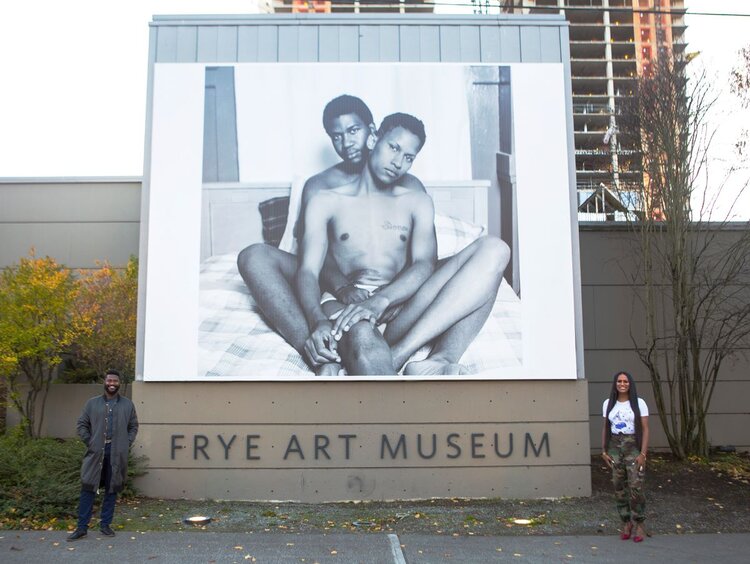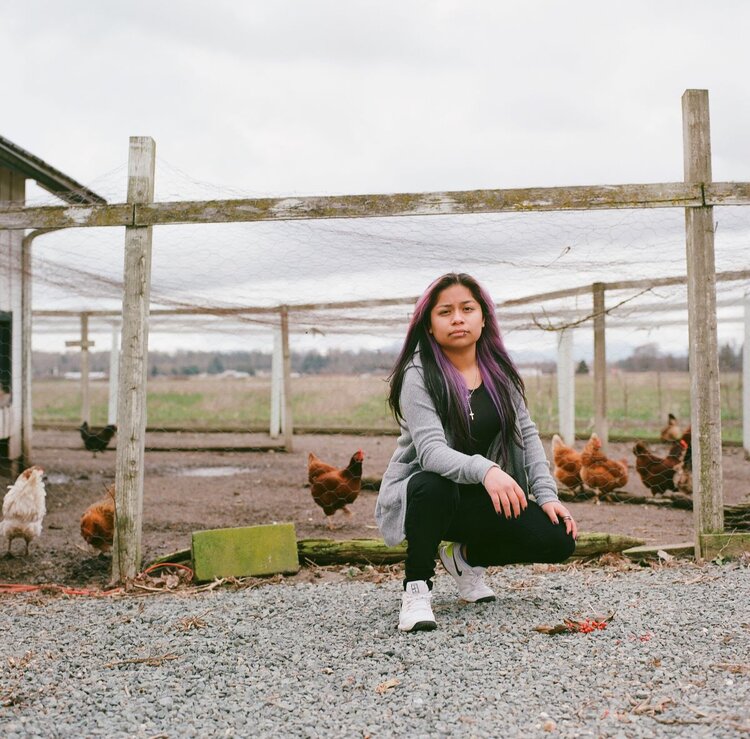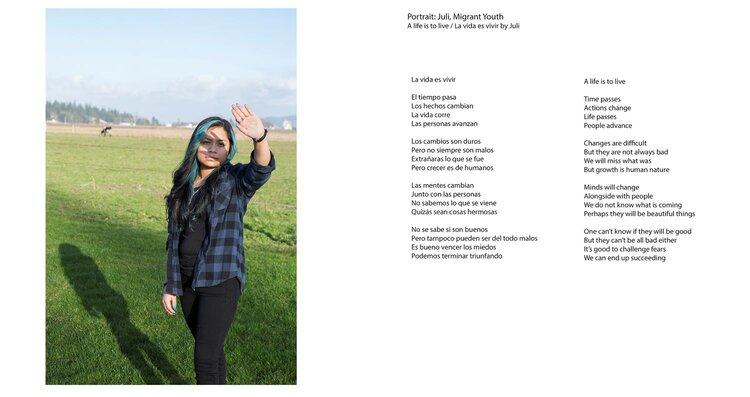Artist Marilyn Montufar, whose photograph Ronnie and Cleveland is on view as part of the Boren Banner Series through April 11, 2021, shares insights into this work as well as a forthcoming project.
My photography is rooted in personal experiences informed by my Xicana upbringing, raised by my single mother who was a migrant from Mexico and my uncle who is a double minority as a gay Latinx male. However, when I create art, my intention is to extend a universal empathetic understanding.

Ronnie (left) and Chanel (right) in front of the Boren Banner, 2020. Photo: Marilyn Montufar
When my photograph Ronnie and Cleveland inaugurated the Frye Art Museum’s Boren Banner Series, it revealed the healing power of visibility through the eyes of featured models Chanel Blac Lumiere (formerly known as Cleveland) and Ronnie Clark, who witnessed their portrait unfold on the facade of the museum fourteen years after the original photographic sitting. Chanel, a transgender activist, sits in front of her (former) partner Ronnie. The photograph documents their journey navigating identity within the LGBTQIA community in South Central Los Angeles. As Chanel stated in our Frye Virtual Visit, “Back then, I didn’t identify as trans, but all of that was leading to this moment in my identity.” Chanel describes the banner as an important step for future generations to see themselves and be accepted: “When we talk about visibility, right, our visibility, not only mine, but Marilyn and Ronnie’s as well, what it does for us [is] it allows others to understand us. And the more we are visible, the more we are normalized in society…Imagine the young child who may see [the banner] and says, ‘Hey, that may be me one day!’” Last November, when Chanel and Ronnie visited the banner in Seattle, an instant joy lit their faces, compounded with tears—emotions of what it feels to be seen, to be heard, and to be celebrated.
Similarly to Chanel and Ronnie, I was raised in a high-risk neighborhood in Los Angeles. I started creating photography as a youth. The lack of diverse representation in mentors, arts education, and later in life at art residencies, galleries, and museums, beckoned the question: where is there room in the arts for myself and communities underrepresented in the arts? It is the desire and urgency to see our stories reach equality in the arts which motivates me to create photography. I believe that there needs to be more opportunities for diverse voices today, not tomorrow, and the time for change is now. As Ronnie stated, “For the youth…it is a form of violence, the lack of seeing yourself. The internal violence that it triggers…feeling that you are less than.” Ronnie's words spoke urgency to the need to continue outreach to underrepresented youth in the region. Having participated in the Boren Banner Series and seeing the potential it has to elevate a community, my next project focuses on uplifting youth who are part of the “invisible workforce” in Washington.

Marilyn Montufar. Juli at the farm, 2021. Archival pigment print. 30 x 30 in. Courtesy of the artist.
In 2020, when I learned that the pandemic was disproportionately impacting farm working communities in Washington, I set out to reach out to one of these communities in remote regions of the state and learned about the work by Migrant Leaders Club (with educator Marco Morales) and Underground Writing. This inspired me to create a photo series focused on female youth who reside in Mount Vernon, WA and propose the idea of a tripartite collaboration. The project bridges photography with youth writing to address how Latinx communities have been deeply impacted by the COVID-19 pandemic due to lack of resources, healthcare accessibility, and language barriers.


Photo: Marco Morales. Courtesy of the
artists.
Similar to my work with Chanel and Ronnie on the Boren Banner Series, I wished to continue highlighting the model’s perspective in the art-making process—in this case, through their writing. Matt Malyon, Executive Director of Underground Writing, states, “From our side, it seemed like an ideal fit right from the start. Marilyn’s photography work is beautiful and filled with narrative potential, the students have been photographed in an honoring way, and each participating student has had the opportunity to work on new writings to accompany the images.” Although the migrant youth project (working title) is the beginning of a new venture that is evolving, we are proud that the project is included in the exhibition Crowd Within at the Jacob Lawrence Gallery, spotlighting collaborations in art-making created by the 2020 Neddy Award finalists, showcased until March 27th.
As reflected by Morales, “The arts are often very exclusive, and in offering the youth an opportunity to showcase their talents I believe the students are able to participate in a genuine way that feels authentic to their experience. An experience that is not often showcased, but has a lot to teach us as migrant students are often marginalized. Education as a project was not ever designed with them in mind.”
My hope is that in mentoring and extending a platform for migrant youth, new stories emerge, a truth that speaks to the power of being seen as part of our local community. And in turn, their impact will increase inclusion in the arts leading to more visibility and equitable opportunities—a step for future generations to see themselves reflected in the arts.
